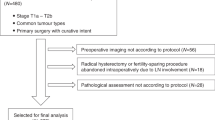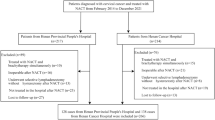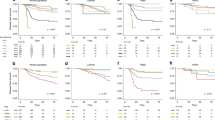Abstract
Background
The aim of the present study was to assess the prognostic value of tumour-free distance (TFD), defined as the minimum distance of uninvolved stroma between the tumour and peri-cervical stromal ring, in early-stage cervical cancer.
Methods
Patients with pathologic FIGO 2009 stage IA1–IIA2 cervical cancer, treated by primary radical surgical treatment between 01/2000 and 11/2019, were retrospectively included. Adjuvant treatment was administered according to the presence of previously established pathologic risk factors. TFD was measured histologically on the hysterectomy specimen. Pre-operative TFD measured at MRI-scan from a cohort of patients was reviewed and compared with pathology TFD.
Results
395 patients were included in the study. 93 (23.5%) patients had TFD ≤ 3.0 mm and 302 (76.5%) had TFD > 3.0 mm. TFD ≤ 3.0 mm together with lymph vascular space involvement represented the strongest predictor for lymph node metastasis at multivariate analysis. TFD ≤ 3.0 mm was associated with worse 5-year disease-free survival (DFS) and overall survival (OS), compared with TFD > 3.0 mm (p = 0.022 and p = 0.008, respectively). DFS difference was more evident in the subgroup of patients with low-risk factors who did not receive adjuvant treatment (p = 0.002). Cohen’s kappa demonstrated an agreement between TFD measured at pre-operative MRI-scan and histology of 0.654.
Conclusions
Pathologic TFD ≤ 3.0 mm represents a poor prognostic factor significantly associated with lymph node metastasis and it may be considered a novel marker to select candidates for adjuvant treatment. The possibility to obtain this parameter by radiological imaging makes it a potential easy-measurable pre-operative marker to predict the presence of high-risk pathologic factors in early-stage cervical cancer.
This is a preview of subscription content, access via your institution
Access options
Subscribe to this journal
Receive 24 print issues and online access
$259.00 per year
only $10.79 per issue
Buy this article
- Purchase on Springer Link
- Instant access to full article PDF
Prices may be subject to local taxes which are calculated during checkout



Similar content being viewed by others
References
Brisson, M., Kim, J. J., Canfell, K., Drolet, M., Gingras, G., Burger, E. A. et al. Impact of HPV vaccination and cervical screening on cervical cancer elimination: a comparative modelling analysis in 78 low-income and lower-middle-income countries. Lancet 395, 575–590 (2020).
Wright, T. C., Stoler, M. H., Behrens, C. M., Sharma, A., Zhang, G. & Wright, T. L. Primary cervical cancer screening with human papillomavirus: end of study results from the ATHENA study using HPV as the first-line screening test. Gynecol. Oncol. 136, 189–197 (2015).
Arbyn, M., Weiderpass, E., Bruni, L., de Sanjosé, S., Saraiya, M., Ferlay, J. et al. Estimates of incidence and mortality of cervical cancer in 2018: a worldwide analysis. Lancet Glob. Health 8, e191–e203 (2020).
Cibula, D., Pötter, R., Planchamp, F., Avall-Lundqvist, E., Fischerova, D., Haie Meder, C. et al. The European Society of Gynaecological Oncology/European Society for Radiotherapy and Oncology/European Society of Pathology guidelines for the management of patients with cervical cancer. Int J. Gynecol. Cancer 28, 641–655 (2018).
Sedlis, A., Bundy, B. N., Rotman, M. Z., Lentz, S. S., Muderspach, L. I. & Zaino, R. J. A randomized trial of pelvic radiation therapy versus no further therapy in selected patients with stage IB carcinoma of the cervix after radical hysterectomy and pelvic lymphadenectomy: a Gynecologic Oncology Group Study. Gynecol. Oncol. 73, 177–183 (1999).
Rotman, M., Sedlis, A., Piedmonte, M. R., Bundy, B., Lentz, S. S., Muderspach et al. A phase III randomized trial of postoperative pelvic irradiation in Stage IB cervical carcinoma with poor prognostic features: follow-up of a gynecologic oncology group study. Int J. Radiat. Oncol. Biol. Phys. 65, 169–176 (2006).
Peters, W. A. 3rd, Liu, P. Y., Barrett, R. J. 2nd, Stock, R. J., Monk, B. J., Berek, J. S. et al. Concurrent chemotherapy and pelvic radiation therapy compared with pelvic radiation therapy alone as adjuvant therapy after radical surgery in high-risk early-stage cancer of the cervix. J. Clin. Oncol. 18, 1606–1613 (2000).
Allam, M., Feely, C., Millan, D., Nevin, J., Davis, J. & Siddiqui, N. Depth of cervical stromal invasion as a prognostic factor after radical surgery for early stage cervical cancer. Gynecol. Oncol. 93, 637–641 (2004).
Van de Putte, G., Lie, A. K., Vach, W., Baekelandt, M. & Kristensen, G. B. Risk grouping in stage IB squamous cell cervical carcinoma. Gynecol. Oncol. 99, 106–112 (2005).
Zhu, J., Cao, L., Wen, H., Bi, R., Wu, X. & Ke, G. The clinical and prognostic implication of deep stromal invasion in cervical cancer patients undergoing radical hysterectomy. J. Cancer 11, 7368–7377 (2020).
Derks, M., van der Velden, J., de Kroon, C. D., Nijman, H. W., van Lonkhuijzen, L., van der Zee, A. et al. Surgical treatment of early-stage cervical cancer: a multi-institution experience in 2124 cases in The Netherlands over a 30-year period. Int J. Gynecol. Cancer 28, 757–763 (2018).
Kristensen, G. B., Abeler, V. M., Risberg, B., Trop, C. & Bryne, M. Tumor size, depth of invasion, and grading of the invasive tumor front are the main prognostic factors in early squamous cell cervical carcinoma. Gynecol. Oncol. 74, 245–251 (1999).
Zeng, J., Qu, P., Hu, Y., Sun, P., Qi, J., Zhao, G. et al. Clinicopathological risk factors in the light of the revised 2018 International Federation of Gynecology and Obstetrics staging system for early cervical cancer with staging IB: a single center retrospective study. Med. (Baltim.) 99, e19714 (2020).
Noguchi, H., Shiozawa, K., Tsukamoto, T., Tsukahara, Y., Iwai, S. & Fukuta, T. The postoperative classification for uterine cervical cancer and its clinical evaluation. Gynecol. Oncol. 16, 219–231 (1983).
Inoue, T., Casanova, H. A., Morita, K. & Chihara, T. The prognostic significance of the minimum thickness of uninvolved cervix in patients with cervical carcinoma stages IB, IIA, and IIB. Gynecol. Oncol. 24, 220–229 (1986).
Kishi, Y., Hashimoto, Y., Sakamoto, Y. & Inui, S. Thickness of uninvolved fibromuscular stroma and extrauterine spread of carcinoma of the uterine cervix. Cancer 60, 2331–2336 (1987).
Saatli, B., Olgan, S., Gorken, I. B., Uslu, T., Saygili, U., Dicle, N. et al. Tumor-free distance from outermost layer of cervix is of prognostic value in surgically treated cervical cancer patients: a multicenter study. Arch. Gynecol. Obstet. 289, 1331–1335 (2014).
Cibula, D., Slama, J., Dostálek, L., Fischerová, D., Germanova, A., Frühauf, F. et al. Tumour-free distance: a novel prognostic marker in patients with early-stage cervical cancer treated by primary surgery. Br. J. Cancer https://doi.org/10.1038/s41416-020-01204-w (2020).
Querleu, D., Cibula, D. & Abu-Rustum, N. R. 2017 Update on the querleu-morrow classification of radical hysterectomy. Ann. Surg. Oncol. 24, 3406–3412 (2017).
Bizzarri, N., Pedone Anchora, L., Zannoni, G. F., Santoro, A., Valente, M., Inzani, F. et al. Role of one-step nucleic acid amplification (OSNA) to detect sentinel lymph node low-volume metastasis in early-stage cervical cancer. Int J. Gynecol. Cancer 30, 364–371 (2020).
Kaplan, E. L. & Meier, P. Nonparametric estimation from incomplete observation. J. Am. Stat. Assoc. 53, 457–481 (1958).
Mantel, N. Evaluation of survival data and two new rank order statistics arising in its consideration. Cancer Chemother. Rep. 50, 163–170 (1966).
Cox, D. R. Models and life-tables regression. J. R. Stat. Soc. Ser. B (Methodol.) 34, 187–220 (1972).
Boonstra, H., Oosterhuis, J. W., Oosterhuis, A. M. & Fleuren, G. J. Cervical tissue shrinkage by formaldehyde fixation, paraffin wax embedding, section cutting and mounting. Virchows Arch. A Pathol. Anat. Histopathol. 402, 195–201 (1983).
Macchia, G., Cerrotta, A., Deodato, F., Pappalardi, B., Santoni, R., Campitelli, M. et al. Cervical cancer patterns of care in Italy: a radiation oncology survey of MITO and AIRO GYN groups. Crit. Rev. Oncol. Hematol. 149, 102925 (2020).
Wolfson, A. H., Varia, M. A., Moore, D., Rao, G. G., Gaffney, D. K., Erickson-Wittmann, B. A. et al. ACR Appropriateness Criteria® role of adjuvant therapy in the management of early stage cervical cancer. Gynecol. Oncol. 125, 256–262 (2012).
Cibula, D., Abu-Rustum, N. R., Fischerova, D., Pather, S., Lavigne, K., Slama, J. et al. Surgical treatment of “intermediate risk” lymph node negative cervical cancer patients without adjuvant radiotherapy-A retrospective cohort study and review of the literature. Gynecol. Oncol. 151, 438–443 (2018).
Hirai, Y., Takeshima, N., Tate, S., Akiyama, F., Furuta, R. & Hasumi, K. Early invasive cervical adenocarcinoma: its potential for nodal metastasis or recurrence. BJOG 110, 241–246 (2003).
Diaz De Vivar, A., Roma, A. A., Park, K. J., Alvarado-Cabrero, I., Rasty, G., Chanona-Vilchis, J. G. et al. Invasive endocervical adenocarcinoma: proposal for a new pattern-based classification system with significant clinical implications: a multi-institutional study. Int J. Gynecol. Pathol. 32, 592–601 (2013).
The Royal College of Pathologists. Standards and datasets for reporting cancers. dataset for histological reporting of cervical neoplasia (3rd edition), https://www.rcpath.org/uploads/assets/eb26fb88-3db6-417b-97ee6338ef54dc79/g071cervicaldatasetapril11.pdf (2011).
Acknowledgements
The authors would like to thank the surgical team and the scrub nurses at Policlinico Gemelli IRCCS, Rome, Italy.
Author information
Authors and Affiliations
Contributions
Conceptualisation, N.B. and G.S.; Methodology, N.B., L.P.A., G.F.Z., B.G., G.A., V.G., A.F. and F.F.; Software, N.B. and L.P.A.; Validation, V.G., V.C., G.F., F.F. and A.F.; Formal analysis, N.B., L.P.A.; Investigation, V.C., M.B. and C.F.; Data curation, N.B., V.C., M.B. and C.F.; Writing—original draft preparation, N.B., F.F., G.F. and G.S.; Writing—review & editing V.G., V.C., G.F., F.F., A.F. and G.S.; Supervision, G.F.; Project administration, N.B.
Corresponding author
Ethics declarations
Ethics approval and consent to participate
The present study was approved by Institutional Review Board (Number DIPUSVSP-03-02-208, date: 03/02/2020) and performed in accordance with the Declaration of Helsinki.
Consent to publish
Not applicable.
Data availability
Authors agree to make data and materials supporting the results or analyses presented in their paper available upon reasonable request. It is up to the author to determine whether a request is reasonable.
Competing interests
he authors declare no competing interests.
Funding information
None.
Additional information
Publisher’s note Springer Nature remains neutral with regard to jurisdictional claims in published maps and institutional affiliations.
Supplementary information
Rights and permissions
About this article
Cite this article
Bizzarri, N., Pedone Anchora, L., Zannoni, G.F. et al. Validation of tumour-free distance as novel prognostic marker in early-stage cervical cancer: a retrospective, single-centre, cohort study. Br J Cancer 125, 561–568 (2021). https://doi.org/10.1038/s41416-021-01384-z
Received:
Revised:
Accepted:
Published:
Issue Date:
DOI: https://doi.org/10.1038/s41416-021-01384-z
This article is cited by
-
Comment on “Pathological complete response, category change, and prognostic significance of HER2-low breast cancer receiving neoadjuvant treatment: a multicenter analysis of 2489 cases”
British Journal of Cancer (2024)
-
Survival outcomes of abdominal radical hysterectomy, laparoscopic radical hysterectomy, robot-assisted radical hysterectomy and vaginal radical hysterectomy approaches for early-stage cervical cancer: a retrospective study
World Journal of Surgical Oncology (2023)



